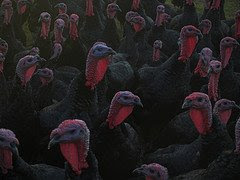

Hi all, you have yourselves a nice family spell.
Thanksgiving has really evolved into a school holiday/chance to spend time with family, elders (before they pass) take family photos, connect the cousins, eat lots of food-kind of time. That's cool.
Most of us know that it is a sanctioned pig-out, we don't always do this to our systems.
We indulge, we eat, we burp. Maybe walk around the block to work it off. Maybe hit the gym a little harder afterwards. All cool.
Lotsa food.
Just thought I would explore the origins of "the bird".
Our photo here indicates a bunch of these ground-living birds, looking astute and colorful.
We all like to think that our holiday centerpiece, the bird, resembles those of our ancestors, the Pilgrims.
However, the bird has a history older than we realize.
And the menu.... forget about it.
Kathleen Curtin, Food Historian at Plymouth Plantation shares this info.
"Surprisingly, the following foods, all considered staples of the modern Thanksgiving meal, didn't appear on the Pilgrims's first feast table:
Ham: There is no evidence that the colonists had butchered a pig by this time, though they had brought pigs with them from England.
Sweet Potatoes/Potatoes: These were not common.
Corn on the Cob: Corn was kept dried out at this time of year.
Cranberry Sauce: The colonists had cranberries but no sugar at this time.
Pumpkin Pie: It's not a recipe that exists at this point, though the pilgrims had recipes for stewed pumpkin.
Chicken/Eggs: We know that the colonists brought hens with them from England, but it's unknown how many they had left at this point or whether the hens were still laying.
Milk: No cows had been aboard the Mayflower, though it's possible that the colonists used goat milk to make cheese."
Who knew?
And for the bird, I share a photo of a large, unassuming warehouse in Longmont, CO, that bears the sign, Butterball. It has come to that.
Bon appetite.



No comments:
Post a Comment